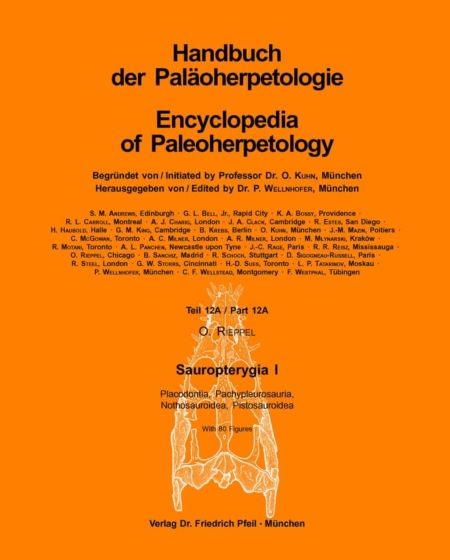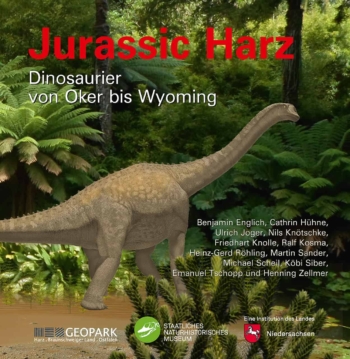According to the original concept of this Handbuch series, the Sauropterygia were supposed to be treated in a single volume, Part 12. However, the increase of new fossil material and intensive research has led to a wealth of published data during the last decades. As a consequence, the Sauropterygia as a whole had to be split into two parts for the Handbuch purposes, resulting in Part 12A dealing with the Triassic Nothosauria, and Part 12B dealing with the post-Triassic Plesiosauria. Now, the organization of the two volumes will follow the new concept of Rieppel, understanding the Sauropterygia as a clade divided into stem-group Sauropterygia from the Triassic, comprising Placodontia and Eosauropterygia (sensu RIEPPEL) combined in this volume, Part 12A, Sauropterygia I. Placodontia, Pachypleurosauria, Nothosauroidea, Pistosauroidea, and into crown-group Sauropterygia from the Jurassic and Cretaceous, Part 12B, in preparation, comprising plesiosaurs, pliosaurs and elasmosaurs. In addition, inclusion of the Placodontia in this volume has the advantage of presenting an updated revision of this group as a whole not only in the context of this Handbuch series, but also in general.
HPH 12A • Sauropterygia I.
2000. [in English] – X + 134 pp., 80 figures.
25.5 x 20.5 cm, Hardcover.
Series: Handbook of Paleoherpetology
100,00 €
plus shipping costs
Foreword (P. WELLNHOFER) V
Acknowledgements VI
Institutional Acronyms VII
Figure Abbreviations VIII
Introduction: History of the Concept of Sauropterygia 1
Phylogenetic Relationships of Stem-Group Sauropterygia 4
Stratigraphic and Geographic Distribution of Stem-Group Sauropterygia 6
General Skeletal Anatomy of Stem-Group Sauropterygia 10
Systematic Review 16
Superorder Sauropterygia OWEN, 1860 16
Order Placodontia COPE, 1871 16
Suborder Placodontoidea COPE, 1871 16
Family Paraplacodontidae PEYER & KUHN-SCHNYDER, 1955 17
Anatomy of Paraplacodontidae 17
Genus Paraplacodus PEYER, 1931 18
Family Placodontidae COPE, 1871 19
Anatomy of Placodontidae 19
Genus Placodus AGASSIZ, 1933 21
Suborder Cyamodontoidea NOPCSA, 1923 23
Anatomy of Cyamodontoidea 23
Interrelationships of Cyamodontoidea 25
Superfamily Cyamodontida NOPCSA, 1923 25
Family Henodontidae F. V. HUENE, 1948 26
Genus Henodus F. V. HUENE, 1936 26
Family Cyamodontidae NOPCSA, 1923 27
Genus Cyamodus MEYER, 1863 27
Superfamily Placochelyida ROMER, 1956 32
Family Macroplacidae nov. fam. 32
Genus Macroplacus SCHUBERT-KLEMPNAUER, 1975 32
Family Protenodontosauridae nov. fam. 33
Genus Protenodontosaurus PINNA, 1990 33
Family Placochelyidae ROMER, 1956 34
Genus Placochelys JAEKEL, 1902 34
Genus Psephoderma MEYER, 1858 36
Genus Psephosaurus E. FRAAS, 1896 38
Cyamodontoidea indet. 39
Order Eosauropterygia RIEPPEL, 1994 41
Suborder Pachypleurosauria NOPCSA, 1928 41
Family Pachypleurosauridae NOPCSA, 1928 41
Anatomy of Pachypleurosauridae 42
Interrelationships of Pachypleurosauridae 44
Genus Anarosaurus DAMES, 1890 45
Genus Dactylosaurus GÜRICH, 1884 46
Genus Hanosaurus YOUNG, 1972 49
Genus Keichousaurus YOUNG, 1958 50
Genus Neusticosaurus SEELEY, 1882 51
Genus Serpianosaurus RIEPPEL, 1989 56
Pachypleurosauria incertae sedis 57
Suborder Eusauropterygia TSCHANZ, 1989 58
Infraorder Nothosauroidea BAUR, 1889 58
Superfamily Simosauria nov. superfam. 58
Family Simosauridae F. V. HUENE, 1948 58
Anatomy of Simosauridae 58
Genus Simosaurus MEYER, 1842 61
Superfamily Nothosauria BAUR, 1889 64
Family Germanosauridae nov. fam. 64
Genus Germanosaurus NOPCSA, 1928 64
Family Nothosauridae BAUR, 1889 66
Genus Nothosaurus MÜNSTER, 1834 66
Genus Lariosaurus CURIONI, 1847 86
Nothosauria incertae sedis 96
Infraorder Pistosauroidea BAUR, 1887-90 97
Superfamily Cymatosauria E.V. HUENE, 1944 97
Family Cymatosauridae E.V. HUENE, 1944 97
Anatomy of Cymatosauridae 97
Genus Corosaurus CASE, 1936 98
Genus Cymatosaurus FRITSCH, 1894 98
Superfamily Pistosauria BAUR, 1887-90 104
Family Pistosauridae BAUR 1887-90 105
Genus Augustasaurus SANDER, RIEPPEL & BUCHER, 1997 105
Genus Pistosaurus MEYER, 1839 105
Pistosauroidea incertae sedis 106
Genus Chinchenia YOUNG, 1965 107
Genus Kwangsisaurus YOUNG, 1959 107
Problematic taxa of unknown affinities 108
Taxa which have been placed within the Sauropterygia, but must be excluded 109
A list of names currently recognized as nomina dubia 110
Functional Anatomy of Triassic Stem-Group Sauropterygia 111
Life History of Triassic Stem-Group Sauropterygia 114
Evolution of Triassic Stem-Group Sauropterygia 114
Historical Biogeography of Triassic Stem-Group Sauropterygia 116
Avenues for Future Research 119
Literature Cited 120
Index of Genera and Higher Taxa 133
The Initiator of the Handbuch der Paläoherpetologie / Encyclopedia of Paleoherpetology, the late Professor Dr. Oskar Kuhn, started this series in 1969. The first volume to be published, written by Professor Kuhn himself, was Part 9, which included a variety of different reptilian groups of partly uncertain phylogenetic relationships. One of these was the Placodontia for which Kuhn established a subclass of its own, Placodontomorpha, considered to have no sauropterygian affinities. From the beginning of their discovery, the placodonts have posed special problems, as is shown in detail by the author of this volume. Even in recent textbooks they are still classified as Diapsida incertae sedis, yet not closely related to sauropterygians.
Based on detailed phylogenetic analysis, the author of this volume has found placodonts consistently to be the sister-taxon of the Sauropterygia (RIEPPEL, 1994a; see also STORRS, 1991; RIEPPEL & ZANON, 1997). Following these results, the Placodontia are here included, considered to be the sister-group of sauropterygians within diapsids.
According to the original concept of this Handbuch series, the Sauropterygia were supposed to be treated in a single volume, Part 12. However, the increase of new fossil material and intensive research has led to a wealth of published data during the last decades. As a consequence, the Sauropterygia as a whole had to be split into two parts for the Handbuch purposes, resulting in Part 12A dealing with the Triassic Nothosauria, and Part 12B dealing with the post-Triassic Plesiosauria. Now, the organization of the two volumes will follow the new concept of Rieppel, understanding the Sauropterygia as a clade divided into stem-group Sauropterygia from the Triassic, comprising Placodontia and Eosauropterygia (sensu RIEPPEL 1994a) combined in this volume, Part 12A, Sauropterygia I. Placodontia, Pachypleurosauria, Nothosauroidea, Pistosauroidea, and into crown-group Sauropterygia from the Jurassic and Cretaceous, Part 12B, in preparation, comprising plesiosaurs, pliosaurs and elasmosaurs.
In addition, inclusion of the Placodontia in this volume has the advantage of presenting an updated revision of this group as a whole not only in the context of this Handbuch series, but also in general.
Dr. Peter Wellnhofer, München
Editor
You must be logged in to post a review.
"*" indicates required fields
Related products
We’re here for you
Verlag Dr. Friedrich Pfeil
Hauptstraße 12B
5232 Bergkirchen OT Günding – Germany
Tel.: +49 8131 61 46 590
Fax: +49 8131 61 46 591
E-Mail: info@pfeil-verlag.de
Contact
Tel.: +49 89 742827-0
Fax: +49 89 7242772
E-Mail: info@pfeil-verlag.de






Reviews
There are no reviews yet.